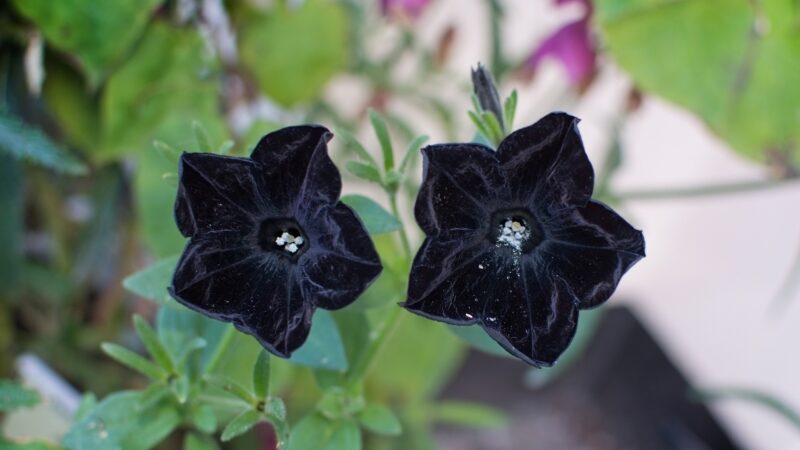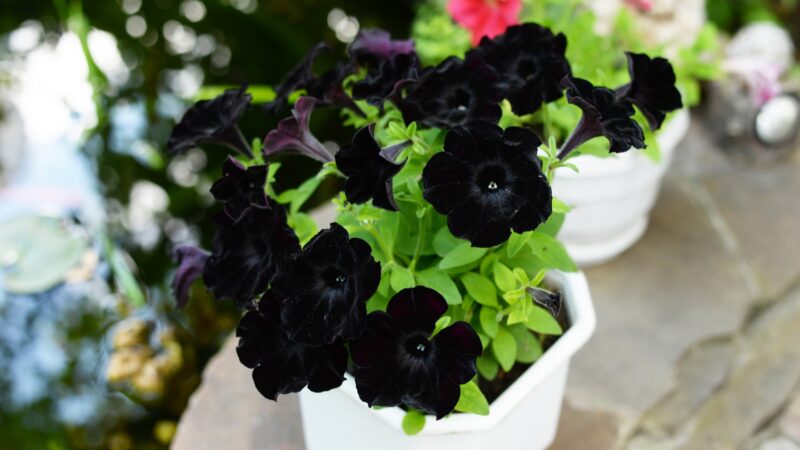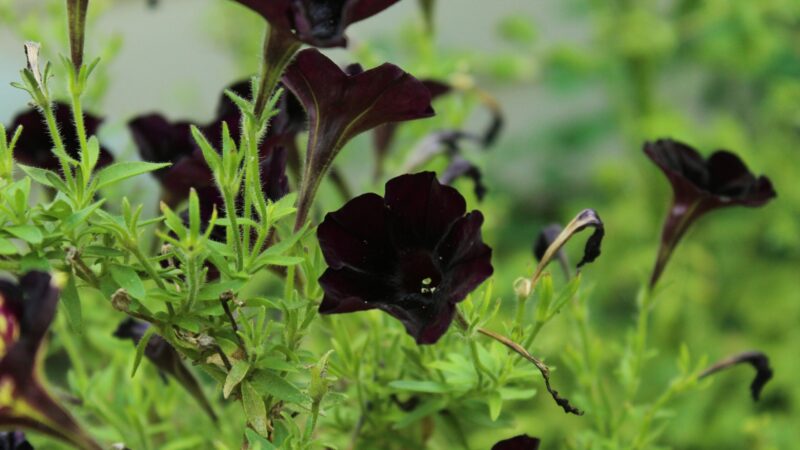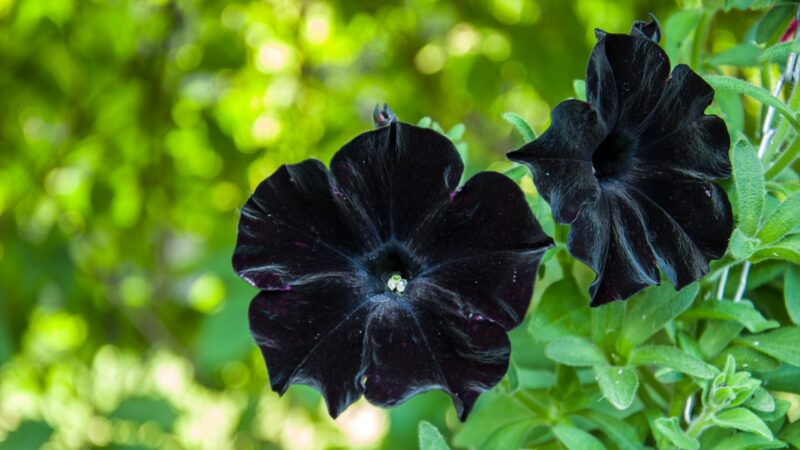Petunias are popular flowering plants due to their fragrance and attractive blooms. One interesting variety is the Black Petunia, with its black, sometimes tinged with purple, flowers that provide a great addition to landscapes and are even grown as houseplants.
To take care of black petunia plants, place them in areas where they can receive at least 5 to 6 hours of sun every day, then water weekly. Soil temperature should range from 55°F to 65°F with good drainage.
Apply a balanced or timed-release fertilizer at the time of planting before using a liquid fertilizer. Transplant them in the spring season when grown by propagation.
This article discusses everything you need to know about growing and taking care of black petunias, their physical attributes, distinctive characteristics, and other interesting information. Read further for more!
What Is Black Petunia?

Black Petunias, as the name suggests, are a variety of garden petunias (Petunia hybrida) with black flowers. It is a popular bedding plant used for mass planting color borders, patios, drive entryways, and raised planter beds, as well as houseplants grown in hanging baskets and window boxes.
- General Characteristics: Has a showy, prostrate form with a somewhat spreading growth habit and velvety texture. Most varieties of black petunias available commercially are either trailing or wave types.
- Common Names: Black Velvet Petunia, Black Mamba Petunia
- Appearance: Its leaves are a sticky to grayish-green color, which varies in size from 1.5 to 3 inches. It also has trumpet-shaped, black or blackish purple flowers, sometimes with white speckles depending on the variety, and an inconspicuous fruit.
- Origin: South America
- Indoor or Outdoor Plant: Outdoor Plant
Varieties of Black Petunia Plant
- Black Magic Petunia. This is the blackest variety in the market characterized by non-striping blooms and a trailing but controlled growth habit. It grows to a height of 10 to 16 inches and a width of 16 to 20 inches.
- Black Velvet Petunia. This variety is speckled with little white dots on the surface of its flowers and grows green, pointy leaves that retain their color throughout the season. It grows up to 10 inches in height.
- Black Mamba Petunia. With a blackish purple flower color, this is a short variety that grows to a height of 6 to 10 inches but can spread 18 to 24 inches. This variety is characterized by its fast-growing habit, color retention, and excellent weather tolerance.
- Black Cat Petunia. Has fewer white speckles compared to the Black Velvet and is characterized by an early blooming habit, tolerance to drought, and resistance to diseases.
- Ray Black Petunia. Characterized by large-sized flowers and their early blooming habit, this variety is blackish purple and can grow a height of 12 to 14 inches with a width of 12 to 16 inches.
Where to Plant Black Petunia Plant?

Black Petunias can be planted both in containers or for massing in gardens. They should be placed in a location where they can receive a good amount of sunlight.
Usually, they can tolerate a little shade, but the more shady the location is, the fewer flowers they’ll be able to produce. When planting as ground cover, each plant should be spaced 12 to 18 inches apart.
When to Plant Black Petunia Plant?
Generally, black petunias can be planted once winter frost ends. However, it depends on geographical location. Here are the best planting time depending on the U.S. region you live in:
- Northern regions: Mid-May
- Midwestern regions: Late February to early March or late April
- Southeastern regions: October to November
Take note that gardeners from southern areas should provide protection to the plants against frost or allow them to overwinter indoors if they’re planted in containers.
How to Take Care of Black Petunia Plants?

Lighting
Black petunias need at least 5 to 6 hours of sunlight a day. They perform even better when they’re placed under the full sun exposure for the entire day.
Be wary of excess sunlight, however, since their foliage can be damaged easily. Although black petunias can survive partial shade, their growth may be stunted and become spindly.
Water
Generally, petunias are heat-tolerant, but since black petunias, in particular, are a spreading variety, they require frequent watering, especially during periods of extreme heat, drought, and winter.
For garden plants, watering once a week should suffice. One tip is to leave sprinkler hoses on long enough until the soil is soaked with 6 to 8 inches of deep water.
For container plants, they should be watered daily, but this depends on their size and the amount of soil they utilize.
Temperature and Humidity
Soil temperature should be about 60°F to 75°F during the day and 55°F to 65°F during nighttime. The temperature should not exceed 75°F, or else they will be tall and leggy, which is not an ideal appearance for black petunias.
The plants are not particular to a specific relative humidity content, but for rapid, uniform germination, high relative humidity (near 100%) will provide the best results. This can be achieved by misting the plants now and then.
Soil
This plant does not necessitate nutrient-rich soil, but it must be moderately fertile, evenly moist, and well-drained. Black petunias prefer a soil pH of 6.0 to 7.0 and can tolerate alkaline soil, but excessive alkalinity may stunt plant growth, so make sure to do a soil test before planting.
Improve garden soil by spreading 2 to 3 inches thick of organic matter on the upper surface. Afterward, incorporate it 8 to 10 inches into the soil using a garden fork or rototiller. This helps improve drainage, open up the soil, and increase the ability to hold moisture, light, and nutrients.
Fertilizer
When planting in containers such as in hanging baskets and window boxes, apply a timed-release fertilizer into the plant’s soil, then a liquid fertilizer targeted towards flowering plants every week after establishment.
When planting in a garden, apply a balanced fertilizer, such as a 12-12-12, 10-10-10, or 8-8-8 into the soil at a ratio of 2 pounds every 100 square feet of area, or follow the product label of the fertilizer. Once they have fully established, use liquid fertilizer once every 7 to 10 days.
Potting and Repotting
Any container can work—whether they are hanging baskets, window boxes, or simple porous planters. It does not matter as long as the soil used is well-drained. They can also be planted on the ground when used as bedding plants.
When repotting, the new container must have holes for drainage to remove any excess water. Preferably, it should be glazed or plastic instead of terra cotta to better maintain moisture content.
Add a slow-release fertilizer to the soil of the new container, such as a 5-10-15 or 6-12-12. Transplant the petunias in the spring season.
How to Grow Black Petunia? A Step-by-Step Guide
- Before planting, make sure the soil has a temperature of 60°F and that any dangers of the winter frost have passed.
- If transplanting, place the black petunias 12 to 16 inches apart, depending on how attractively “full” you want them to appear, in a location where they can receive 5 to 6 hours of sunlight every day.
- If growing from seeds:
- Spread them sparingly on top of a container filled with milled sphagnum moss or damp potting mix, then mist water to allow them to wash into the potting material. You can also gently press them toward the soil before watering.
- Place a plastic cover over the container, then store it in a warm location with curtain-filtered sunlight. Once they begin sprouting after 7 to 10 days, remove the cover, then relocate to a cooler location, under a fluorescent light fixture.
- When the seedlings have grown 3 true leaves, transplant them to individual pots, then place them outdoors.
- Feed with a controlled-release product at the time of the planting, then with a diluted liquid fertilizer weekly and water at least 1 to 2 inches every 7 to 10 days once the plants have fully established. Avoid light and frequent waterings to achieve deep rootings.
How to Propagate a Black Petunia Plant?
You can propagate the plant using stem cuttings. This is done by using clean, sterilized scissors to cut stem leaves, dip them in rooting hormone, then place them in a container filled with potting mix.
They can also grow in a jar or vase filled with water as long as the top node of the cuttings remains exposed to air while the rest is submerged. After they have grown roots, transplant them into a new container.
How to Prune a Black Petunia Plant?
Prune stems that look “leggy,” specifically about 1 to 2 inches back past your desired length. You can pinch this branch if they are tender enough or use scissors if necessary. After pinching or pruning, fertilize and water the plants to promote new, robust growth.
If possible, you should also “deadhead” the plants by throwing away any faded flowers to encourage blooming and enhance overall appearance. This process is best done for black petunias grown in containers.
Common Problem With Black Petunia Plant

- Insect problems include aphids, slugs, snails, and flea beetles, although it is not always serious and can easily be controlled using baits.
- Peal blight can happen when the weather gets rainy, very humid, or overcast. Some parts of the plants remain wet for long periods of time and eventually form molds.
- Viruses are also occasional problems, but most black petunia varieties are hybridized to be disease-resistant, so it is not usually a cause for concern.
Frequently Asked Questions
Are Black Petunias Rare?
Black petunias are rare since they are also quite difficult to reproduce. They are rarely available commercially as seeds, which is why transplanting is a more common method.
What Plants Go With Black Petunias?
Black petunias contrast fantastically with brightly-colored flowers, specifically those that are white, pink, gold, or lavender in color. For flowering plants, you can use yellow daisies and African plants. To provide attractive foliage, you can use dusty millers and areca palms.
Are Black Petunia Perennials?
Black petunias are often considered perennials, but they can also be annuals depending on the hardiness zone of where you plant them.